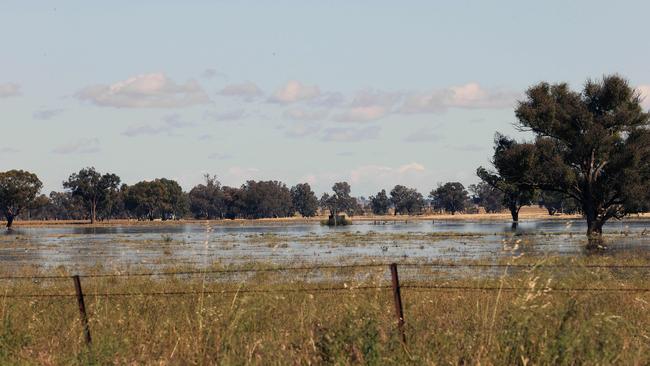Rain report: Crops in danger as heavy rains continue
Southeastern Australia’s bumper harvest hangs in the balance as rain and flooding threaten to downgrade grain quality and yields.
Eastern Australia’s bumper harvest is hanging in the balance after copping a drenching over the past week.
And more rain this week could threaten Australia’s best winter crop in a decade.
There are fears a continued wet harvest would result in downgraded quality of grain and reduced value.
While crops in most areas of Victoria escaped last week’s drenching relatively unscathed, grain growers will be keeping an eye on the sky with 5-100mm forecast for the southeast this week.
While most Queensland grain growers have completed harvest, farmers in central and northern NSW are bracing for more rain this week, fearing it could bring floods with potential to wipe out $100 million-worth of crops, according to reports.

The wet conditions, particularly in Gippsland, continue to cause havoc for hay producers, with many crops still curing on the ground weeks after being cut, while hay on the ground around Forbes in NSW has almost floated away with floodwater.
Victorian Farmers Federation grains group president Ashley Fraser said farmers across the state were “looking to the heavens” and hoping the rest of the season would stay relatively dry.
While growers in northwest Victoria had started harvest, growers in the central and northeast regions were still about 10 days away from starting, he said.
For the majority of Victoria, the recent rain held up windrowing for a couple of days, but was “not a huge impact”, he said.
“The main problems for Victorian growers will come if there is more rain from now.”
Growers across Queensland, NSW and Victoria were expecting a massive harvest this year, with the Australian Bureau of Agricultural and Resource Economics and Sciences predicting a national winter crop harvest of 54.8 million tonnes — 32 per cent above the 10-year average.
Andrew McClenaghan at Bellata in northern NSW said he was waiting to see how bad the rain damage was to his wheat crop, but it appeared some of the crop had begun to sprout and could be downgraded to animal feed.
NSW Farmers Grains Committee Chair Justin Everitt said it was “too early to tell” the full extent of the damage to crops in central and northern NSW.
Rain late in the season “tends to affect the weight of the grain and also affects the protein and the quality,” he said, but “the crops will have to dry out and farmers will have to get the headers back in the paddock before we know what’s happened.”
In Victoria’s Mallee, Jarrod Munro said his hay program had been “significantly damaged” by 14-20mm at the weekend.
The hay had been top grade export quality, but would now likely be sold on the domestic market, he said.
Central West NSW farmer Jarrod Amery, from Forbes, said they had 140mm since the start of the month and were delayed about a fortnight so far.
Mr Amery said his canola, which was predicted to yield three tonnes/ha was in windrows on the ground and was ready to harvest.
“I’m just hoping it hasn’t been ruined by the excessive amount of rain,” he said.

Thomas Elder Markets analyst Andrew Whitelaw said simply, it “just needs to stop raining”.
“We knew there was a potential risk of a wetter than normal harvest, bit we are now seeing it come to fruition,” he said.
Mr Whitelaw said the issue with a wet harvest would be downgraded quality of grain and then reduced value, as well as safety concerns.
“In the past there are always safety concerns with people wanting to get grain off quickly, but this year I’m worried people will try to beat the weather and get it off quickly but without the staff,” he said.
On average across the country, Mr Whitelaw said harvest was delayed about two weeks.
The harvest is still in very early days in NSW. Bulk handler GrainCorp had received 1.1 million tonnes of grain in NSW as of Monday, just 5.6 per cent of the total forecast to come in from the state this season.
In Victoria GrainCorp was in its second week of receivals and had received just 15,500 tonnes as of Monday, a fraction of the 7.7 million tonnes forecast to come in from the state this harvest.
Meanwhile, Victorian Farmers Federation livestock group president Steven Harrison, from Giffard West, said many livestock producers were trying to shear but were also being held up by the rain.
The cold snap has also meant freshly shorn sheep have had to be moved to sheds or protected paddocks.
“I know one farmer stopped shearing on Friday and moved his freshly shorn sheep into the shearing shed to protect them from the cold,” he said.
“But we will take the rain over the dust.”

The latest string of rainy days has played havoc with fodder harvesting for dairy farmers across southeast Australia as well.
Many are redirecting their efforts away from hay towards silage due to the lack of sunshine putting a dampener on curing potential.
United Dairyfarmers of Victoria president Paul Mumford said the wet spring had been frustrating for many primary producers, with power outages a particular bugbear.
“The rain has been relentless for most dairy districts. It’s really set back silage production for many,” he said.
“For farmers close to rivers or with full farm dams, the past week has put them under a lot of pressure, with paddocks under water or heavily bogged.
“The silver lining to all this is that summer is shaping up to be pretty mild.”




